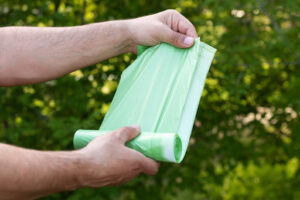It’s no secret that plastics recycling is a huge problem without a great solution. We all generate a ton of plastic waste, but there is no way to recycle it that’s both cost-effective and environmentally sound. There are so many different types of plastic, which makes collection and sorting difficult—plus, plastic degrades when it’s reused, so it has limited value compared to metal, which can be recycled over and over again. The reality is that most plastic waste just won’t be recycled. Recent estimates from the EPA say that about 20 percent of landfill waste is plastic.
The good news is that scientists have been working on alternatives for plastic recycling: specifically, biodegradable plastics and biodegradation methods for destroying existing types of plastic. Both technologies could (theoretically) reduce the amount of plastic waste that ends up in landfills. Neither is a mainstream success story yet, but developments in these areas of research could have a big impact on the way we dispose of plastic in the coming years.
Miller Recycling is paying attention to what’s been happening with plastic recycling research, biodegradable plastics and biotech solutions for plastic. Here’s a quick overview of where things currently stand.
What’s Happening with Biodegradable Plastics?
 Biodegradable plastics have a few major benefits compared to traditional plastics. They can theoretically decompose in months, so they could be composted. Biodegradable plastics that do end up in landfills should virtually disappear, maybe as quickly as within a few months. These products wouldn’t produce microplastics that enter the water stream and damage sea life and humans. Producing biodegradable plastics should also use less fossil fuels and generate fewer greenhouse gases than producing other types of plastic, since biodegradable plastics are made from plants and other bio-based materials.
Biodegradable plastics have a few major benefits compared to traditional plastics. They can theoretically decompose in months, so they could be composted. Biodegradable plastics that do end up in landfills should virtually disappear, maybe as quickly as within a few months. These products wouldn’t produce microplastics that enter the water stream and damage sea life and humans. Producing biodegradable plastics should also use less fossil fuels and generate fewer greenhouse gases than producing other types of plastic, since biodegradable plastics are made from plants and other bio-based materials.
Biodegradable plastics are already in limited use. For example, a number of manufacturers sell plastic bags that claim to be biodegradable or compostable. (Unless you have your own compost heap, you’re probably never going to know how effectively your brand of biodegradable plastic bags break down once they reach the landfill.) There’s also a product called polylactic acid (PLA), a thermoplastic polymer made from plant starch, which is widely used for 3D printing among other purposes.
New biodegradable plastics are also currently being developed. Here’s a quick look at two recent projects:
- Researchers at UC Berkeley created a method for making “real” plastic that biodegrades. The team published their findings in 2021. They designed a process for making polyester plastics that embeds special enzymes in the plastic as it’s being made. When the plastic is exposed to water and heat in the right conditions, the enzymes are activated and start breaking down the plastic. The lead researcher is also working on ways to reuse polyethylene plastic.
- Researchers at the University of Washington have also pioneered a method for creating bioplastics that could potentially be recycled. Their plastics are made from spirulina, a blue-green powder derived from algae, which is formed into shapes using extreme heat and pressure. The researchers noted that their bioplastics are sturdy and fire-resistant but are sensitive to water, which limits their use. Once it’s no longer needed, the material can degrade as quickly as a banana peel would; however, the researchers noted that it could also be broken down using mechanical recycling methods and reformed into new bioplastics.
What’s Happening with Biotech for Recycling Plastics?
Considering biodegradable plastics are still hugely outnumbered by plastic made from crude oil and gas, finding ways to break down all those plastics is a pressing issue. Here are two recent biotech breakthroughs that have the potential to transform plastics recycling:
- Researchers at the University of Sydney have had success breaking down polypropylene using fungi. Polypropylene, used to make everything from yogurt containers to car parts, is one of the most challenging plastics to recycle. The researchers pre-treated polypropylene with either UV light or heat, then exposed the plastic to two strains of fungi. Both strains are commonly found in soil and plants. The plastic had broken down by 21 percent after 30 days, and had biodegraded by 25-27 percent after 90 days.
- Researchers at UT Austin engineered an enzyme that they say has the potential to break down PET plastic in less than a day. They took a natural enzyme and created mutations that would allow bacteria to break down the plastic into tiny pieces. Their discovery is notable because they used AI to create models of the enzyme mutations and predict which one would be most effective. Theoretically, the broken-down components could be “repolymerized” and recycled into new plastic materials!
Need Help with Plastics Recycling?
Miller Recycling keeps our customers informed about recycling advancements and industry news, as well as providing a full range of commercial recycling services. From telling you about the latest advancements around biodegradable plastics, to helping your business manage its own plastic waste, we’re your go-to recycling resource. I’m always happy to answer any questions about our recycling services. Contact me today!

